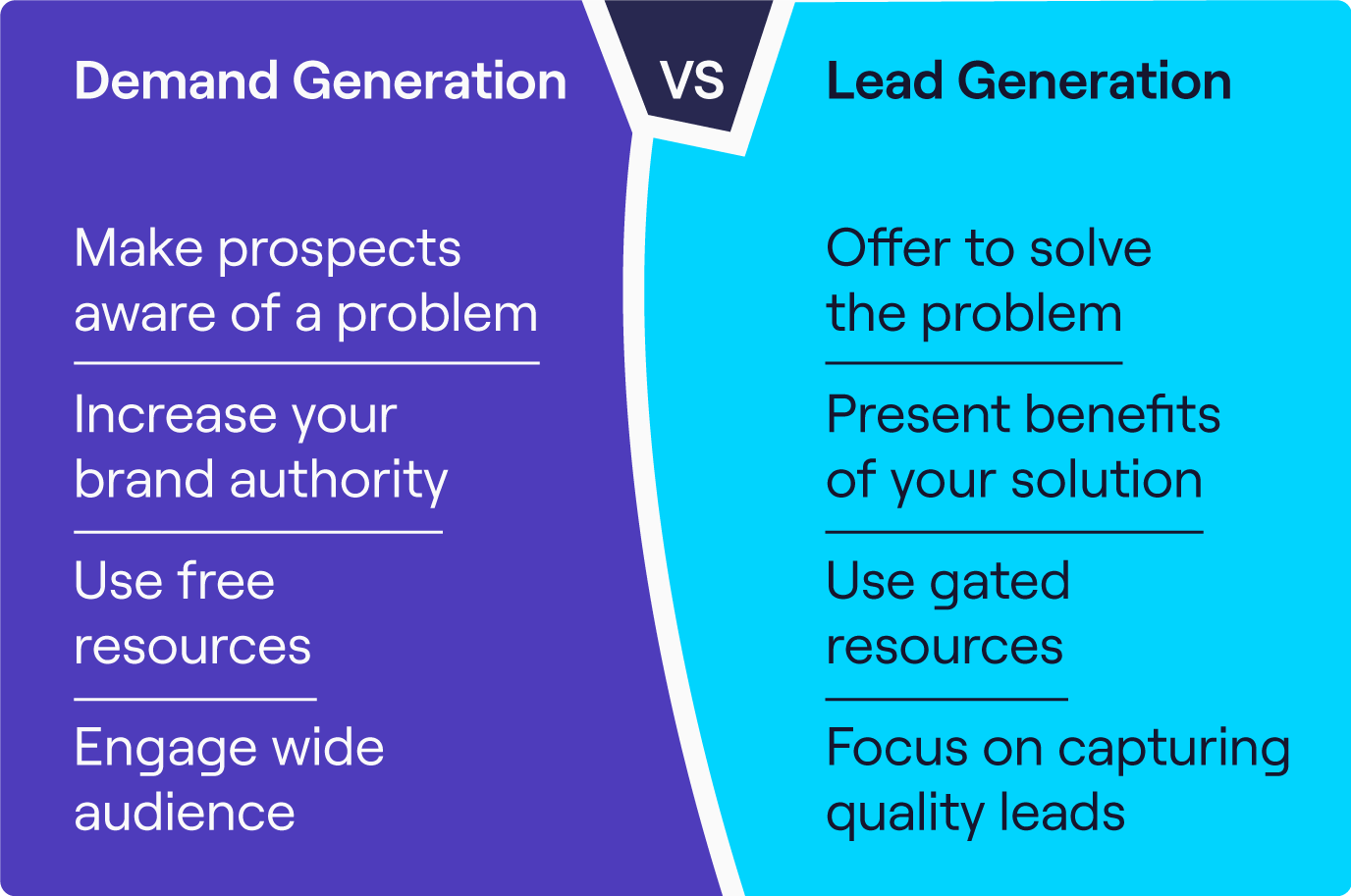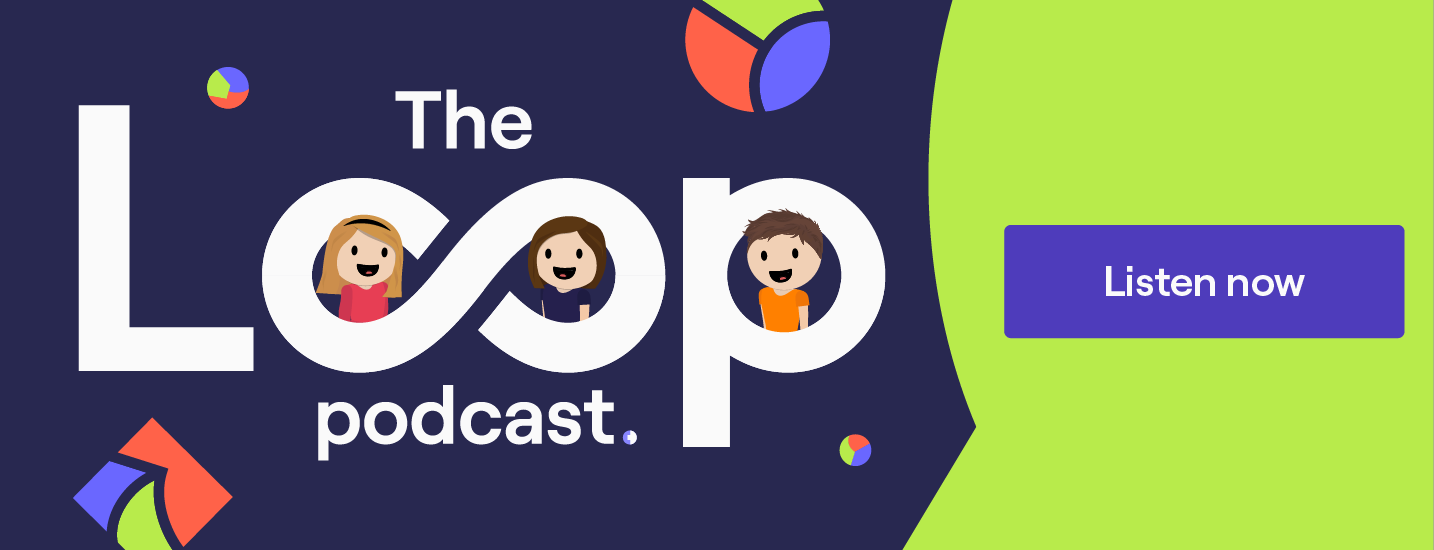Demand Generation vs Lead Generation: The Main Difference
The main difference between demand generation and lead generation is that demand gen is focused on increasing your brand awareness while lead gen aims at converting brand-aware prospects into customers.
If you’re trying to decide which one is more valuable for your business - stop!
Instead of pitting demand generation vs lead generation, you should use the two together for maximum effect.
If you try to do one without the other, you could miss out on significant rewards.
Don’t worry, though. We’ll help you figure everything out.
This article explains:
- The differences between lead gen and demand gen.
- What they have in common.
- How to put them together for the best marketing results.
Scroll 👇 or use the menu to learn everything worth knowing about demand generation vs lead generation.
What is demand generation vs lead generation?
Demand generation creates awareness and interest in a company’s products and services. You can also use its techniques to penetrate new audiences.
Whereas lead generation is when you turn prospects’ attention into hot leads - those who are ready to become customers.
Unlike lead gen, demand gen is less transactional. Here’s why 👇
Demand gen and lead gen activities take place at different stages of the B2B sales funnel. Creating demand is at the very top of the funnel. It’s when you bring prospects into your buying process. For example, when they visit your social media profiles or your homepage.
Lead generation happens once the prospects pass through that stage. They show enough interest in your brand or product to exchange their personal information to learn more. For example, when they register for a demo via a landing page.
Demand generation is higher up the sales funnel and encompasses lead generation. So if you don’t generate enough SQL leads, it can mean you have a problem with generating demand.
It’s simple really!
If people don’t know your brand exists or what problems your solution can fix, it’s hard to convert a prospect into a lead.
Let’s look at the key differences between lead generation and demand generation 👇

1. Goals
- Demand generation aims to build awareness about your company and the problems your company solves. Even if people who learn about this don’t need your solution at the moment, it’s important that they know who can provide the solution when the problem arises.
- For lead generation, the goal is to transform this demand into leads. As the buyer journey continues, it’s natural that your target audience learns about your product. You can then offer to solve prospects’ issues with your product.
2. Engagement
- Demand generation builds trust among your audience and your brand authority. The more you position yourself as a thought leader in your industry, the more people will want to engage with your business.
- Lead generation helps to differentiate your brand and solutions from those of your competitors. It presents all the benefits of using your product.
3. Impact
- Demand generation is about educating your target audience. It typically involves creating free, ungated resources that answer your prospects’ questions.
- Lead generation takes it up a level, with content that’s more explicit about nurturing leads and positioning your brand. It uses gated resources that require contact information.
Check out how Helen Gillbe, EMEA Demand Generation Director at Proofpoint, pivoted from lead generation to demand generation. She explains the differences between the two strategies and the challenges she encountered. 👇
How to bring demand generation and lead generation together?
Modern B2B marketing has shifted from generating as many leads as possible to generating demand.
The reason behind this is that buyers spend more and more time evaluating purchases. What’s more, they often make decisions outside easily measured channels, for example in dark social.
Without solid demand generation, lead generation is cost-inefficient and doesn’t provide the value needed for growth. If your sales team tries to convert leads before they are fully aware of your solution, the conversion rates (e.g. via Facebook or LinkedIn ads) will be low.
That’s why demand generation, unlike lead generation, focuses on constantly providing potential customers with valuable content for free. This strategy captures existing market demand and expands your audience.
Watch this video to find out how Cognism moved from lead gen to demand gen:
But to have lead gen and demand gen working together, it’s essential to have a lead scoring system in place. With this, you’ll know the right time to target leads with more impactful content. Plus, your sales team won’t chase leads that aren’t interested in purchasing.
Creating demand needs different content strategies and different content distribution channels than lead gen. Unlike lead gen, demand gen uses lead sources where there’s low intent to buy, e.g., podcasts or community events.
Being able to differentiate between demand gen vs lead gen also improves alignment between marketing and sales teams. It lets the marketing team develop qualified leads that can be handed over to sales. This makes it easier to set and deliver targets for both teams.
In other words...
Imbalanced lead vs. demand generation results in:
- Unsatisfied customers.
- High customer acquisition cost.
- Misaligned targets for marketing and sales teams.
- Less productive teams.
💡 Learn about the different lead generation companies and services available on the market.
Key takeaways
- Demand generation involves educating people about the problems your product can solve. It does this by creating free content without commercial intent. The aim is to engage a wide audience and increase your brand awareness.
- Lead generation, on the other hand, focuses on highlighting your product’s features and differentiating it from your competitors. The aim is to engage a specific group of people and convert them into paying customers.
- Instead of focusing on lead generation vs demand generation differences, modern marketers should focus on both! Demand gen and lead gen complement one another and should be used in tandem.




